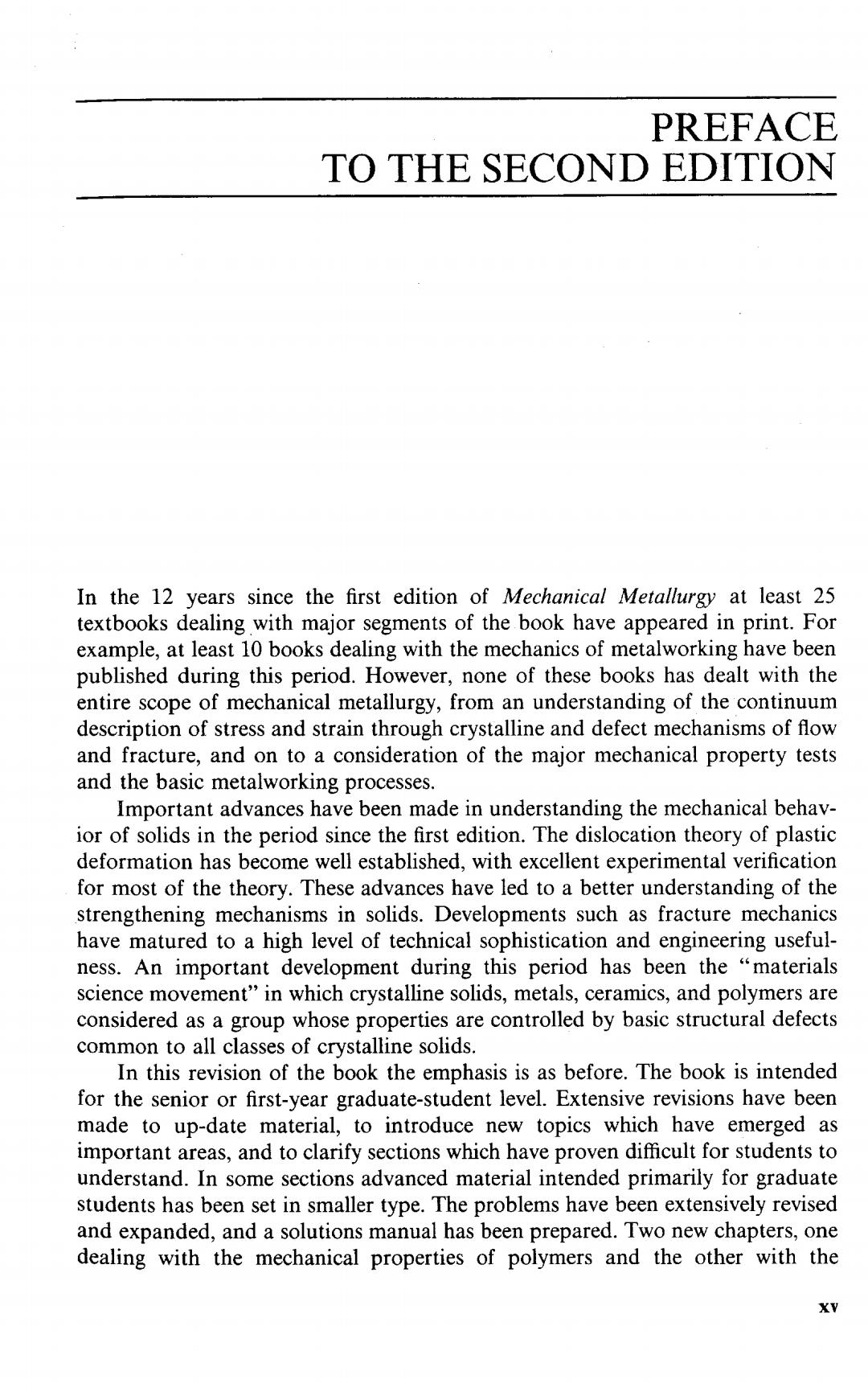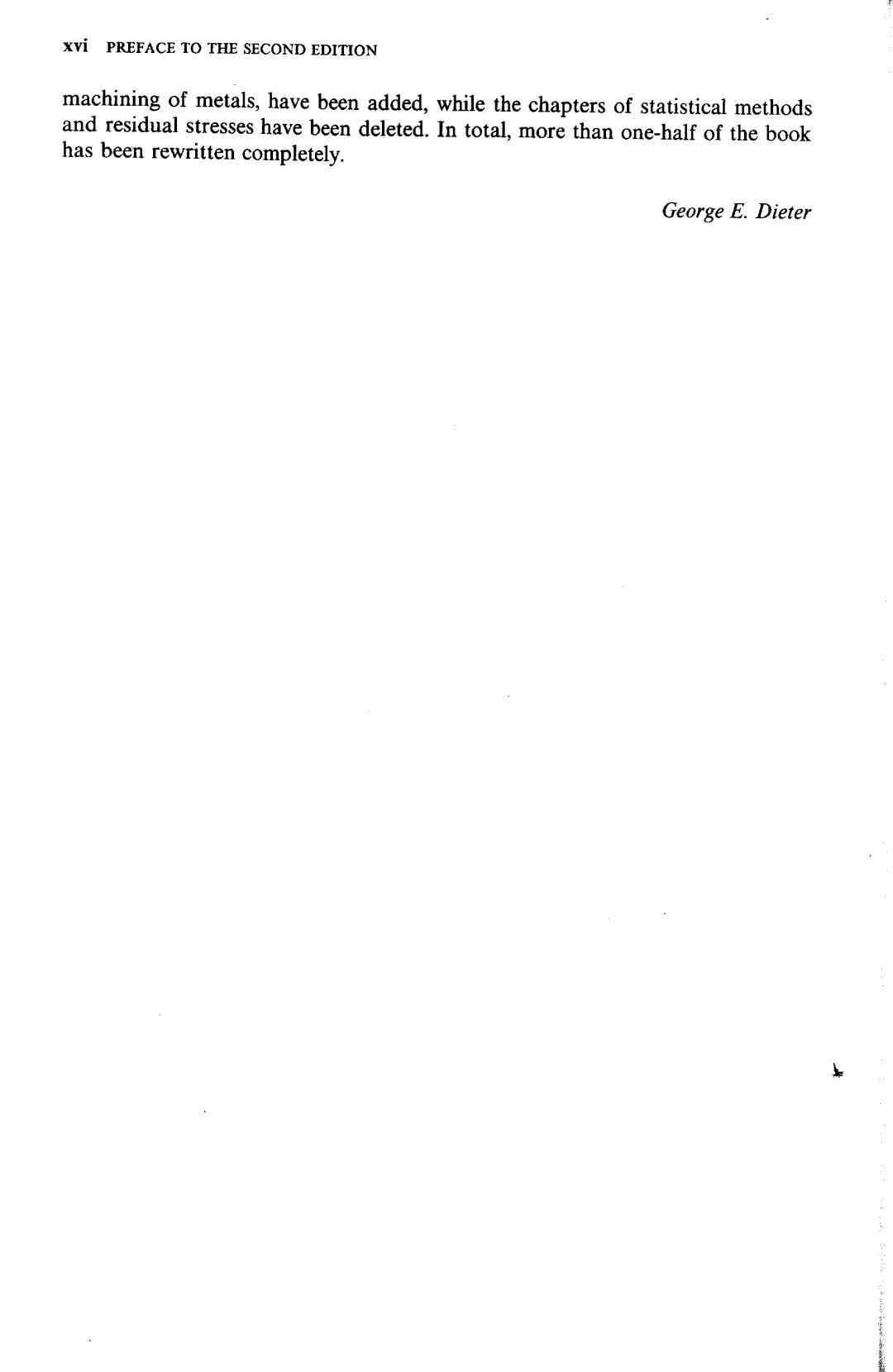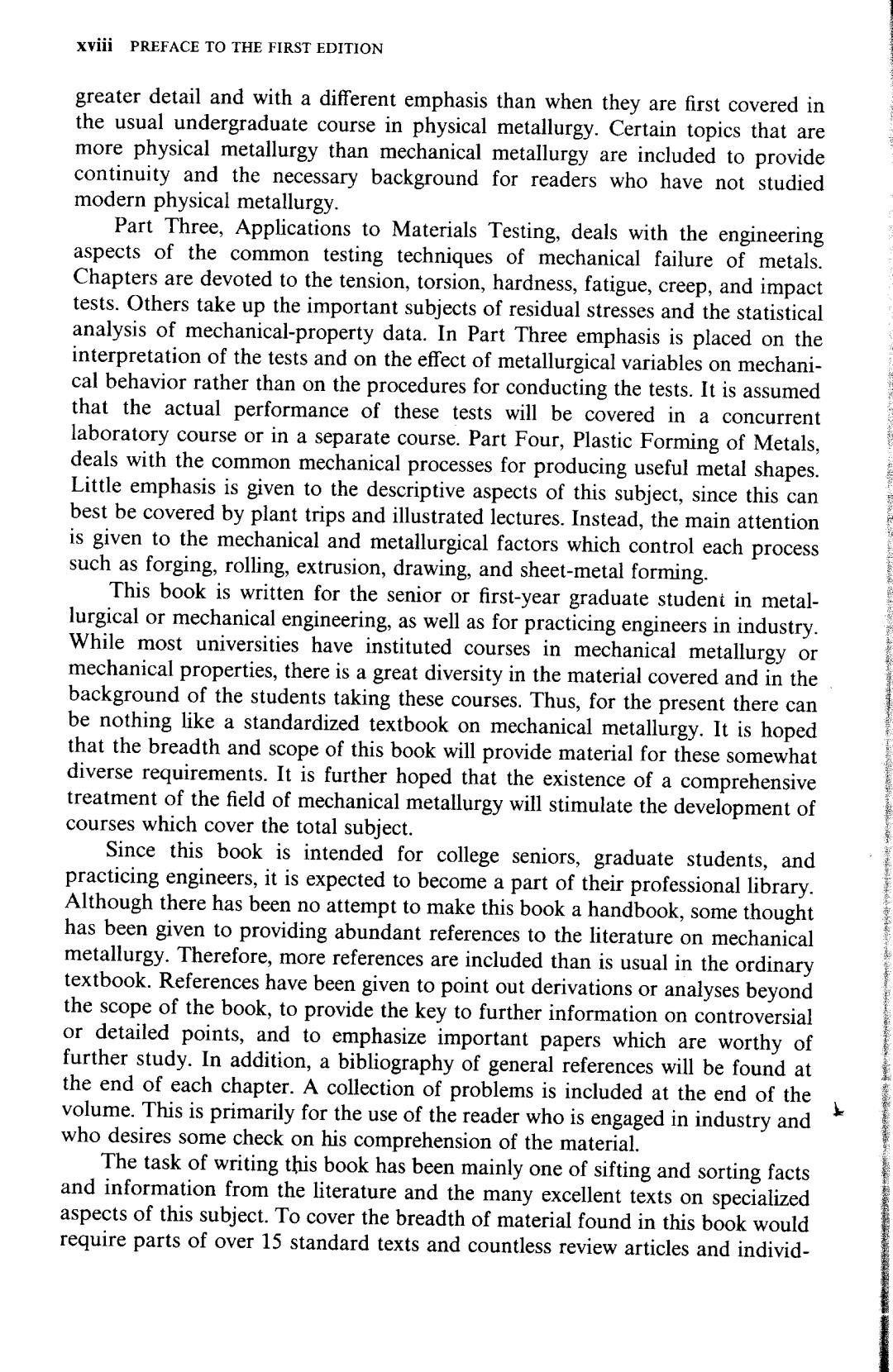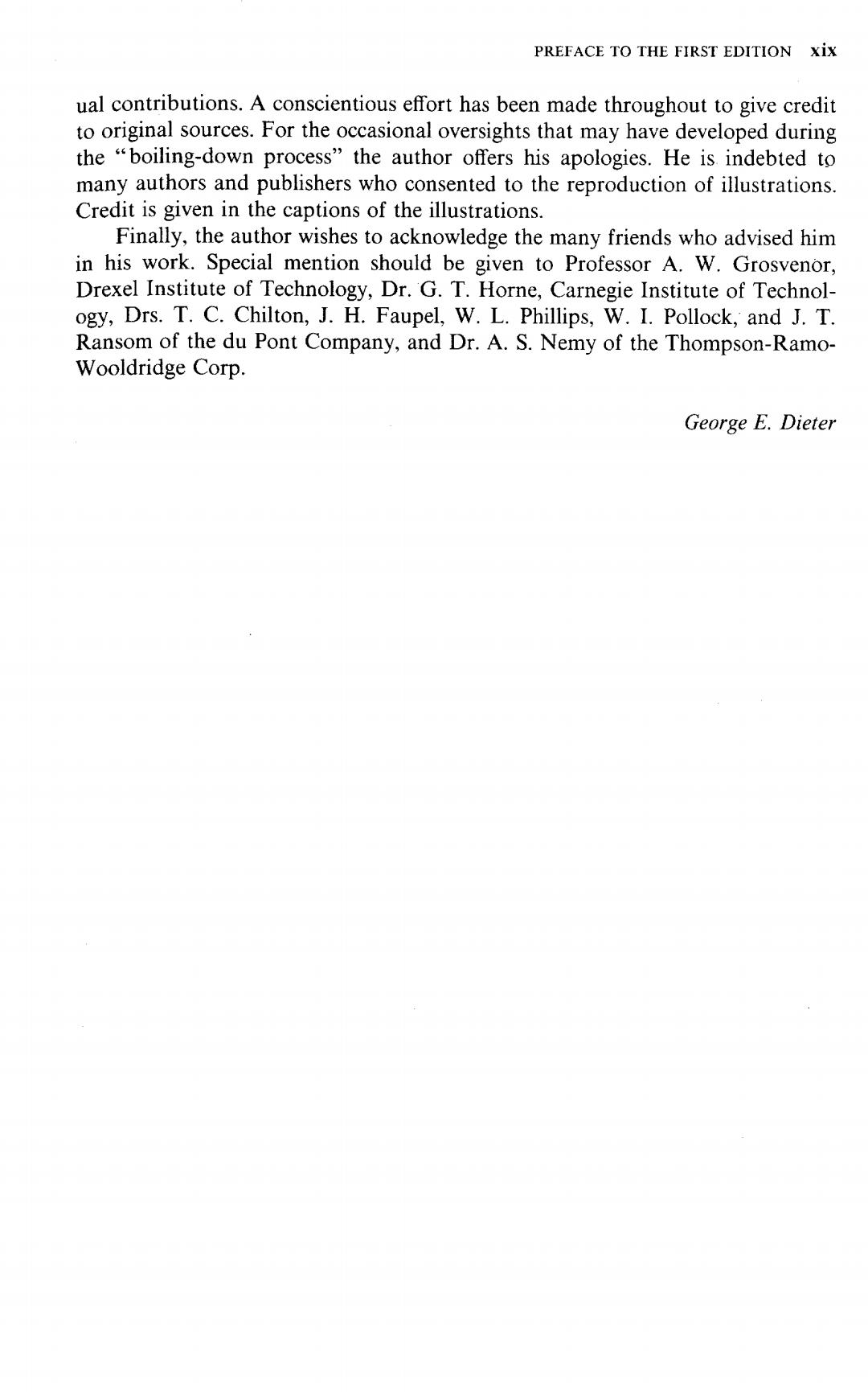
PREFACE TO THE SECOND EDITION In the 12 years since the first edition of Mechanical Metallurgy at least 25 textbooks dealing with major segments of the book have appeared in print.For example,at least 10 books dealing with the mechanics of metalworking have been published during this period.However,none of these books has dealt with the entire scope of mechanical metallurgy,from an understanding of the continuum description of stress and strain through crystalline and defect mechanisms of flow and fracture,and on to a consideration of the major mechanical property tests and the basic metalworking processes. Important advances have been made in understanding the mechanical behav- ior of solids in the period since the first edition.The dislocation theory of plastic deformation has become well established,with excellent experimental verification for most of the theory.These advances have led to a better understanding of the strengthening mechanisms in solids.Developments such as fracture mechanics have matured to a high level of technical sophistication and engineering useful- ness.An important development during this period has been the "materials science movement"in which crystalline solids,metals,ceramics,and polymers are considered as a group whose properties are controlled by basic structural defects common to all classes of crystalline solids. In this revision of the book the emphasis is as before.The book is intended for the senior or first-year graduate-student level.Extensive revisions have been made to up-date material,to introduce new topics which have emerged as important areas,and to clarify sections which have proven difficult for students to understand.In some sections advanced material intended primarily for graduate students has been set in smaller type.The problems have been extensively revised and expanded,and a solutions manual has been prepared.Two new chapters,one dealing with the mechanical properties of polymers and the other with the XV

xvi PREFACE TO THE SECOND EDITION machining of metals,have been added,while the chapters of statistical methods and residual stresses have been deleted.In total,more than one-half of the book has been rewritten completely. George E.Dieter

PREFACE TO THE FIRST EDITION Mechanical metallurgy is the area of knowledge which deals with the behavior and response of metals to applied forces.Since it is not a precisely defined area,it will mean different things to different persons.To some it will mean mechanical properties of metals or mechanical testing,others may consider the field restricted to the plastic working and shaping of metals,while still others confine their interests to the more theoretical aspects of the field,which merge with metal physics and physical metallurgy.Still another group may consider that mechani- cal metallurgy is closely allied with applied mathematics and applied mechanics. In writing this book an attempt has been made to cover,in some measure,this great diversity of interests.The objective has been to include the entire scope of mechanical metallurgy in one fairly comprehensive volume. The book has been divided into four parts.Part One,Mechanical Fundamen- tals,presents the mathematical framework for many of the chapters which follow. The concepts of combined stress and strain are reviewed and extended into three dimensions.Detailed consideration of the theories of yielding and an introduction to the concepts of plasticity are given.No attempt is made to carry the topics in Part One to the degree of completion required for original problem solving. Instead,the purpose is to acquaint metallurgically trained persons with the mathematical language encountered in some areas of mechanical metallurgy.Part Two,Metallurgical Fundamentals,deals with the structural aspects of plastic deformation and fracture.Emphasis is on the atomistics of flow and fracture and the way in which metallurgical structure affects these processes.The concept of the dislocation is introduced early in Part Two and is used throughout to provide qualitative explanations for such phenomena as strain hardening,the yield point, dispersed phase hardening,and fracture.A more mathematical treatment of the properties of dislocations is given in a separate chapter.The topics covered in Part Two stem from physical metallurgy.However,most topics are discussed in xvii

xviii PREFACE TO THE FIRST EDITION greater detail and with a different emphasis than when they are first covered in the usual undergraduate course in physical metallurgy.Certain topics that are more physical metallurgy than mechanical metallurgy are included to provide continuity and the necessary background for readers who have not studied modern physical metallurgy. Part Three,Applications to Materials Testing,deals with the engineering aspects of the common testing techniques of mechanical failure of metals. Chapters are devoted to the tension,torsion,hardness,fatigue,creep,and impact tests.Others take up the important subjects of residual stresses and the statistical analysis of mechanical-property data.In Part Three emphasis is placed on the interpretation of the tests and on the effect of metallurgical variables on mechani- cal behavior rather than on the procedures for conducting the tests.It is assumed that the actual performance of these tests will be covered in a concurrent laboratory course or in a separate course.Part Four,Plastic Forming of Metals, deals with the common mechanical processes for producing useful metal shapes. Little emphasis is given to the descriptive aspects of this subject,since this can best be covered by plant trips and illustrated lectures.Instead,the main attention is given to the mechanical and metallurgical factors which control each process such as forging,rolling,extrusion,drawing,and sheet-metal forming. This book is written for the senior or first-year graduate student in metal- lurgical or mechanical engineering,as well as for practicing engineers in industry. While most universities have instituted courses in mechanical metallurgy or mechanical properties,there is a great diversity in the material covered and in the background of the students taking these courses.Thus,for the present there can be nothing like a standardized textbook on mechanical metallurgy.It is hoped that the breadth and scope of this book will provide material for these somewhat diverse requirements.It is further hoped that the existence of a comprehensive treatment of the field of mechanical metallurgy will stimulate the development of courses which cover the total subject. Since this book is intended for college seniors,graduate students,and practicing engineers,it is expected to become a part of their professional library. Although there has been no attempt to make this book a handbook,some thought has been given to providing abundant references to the literature on mechanical metallurgy.Therefore,more references are included than is usual in the ordinary textbook.References have been given to point out derivations or analyses beyond the scope of the book,to provide the key to further information on controversial or detailed points,and to emphasize important papers which are worthy of further study.In addition,a bibliography of general references will be found at the end of each chapter.A collection of problems is included at the end of the volume.This is primarily for the use of the reader who is engaged in industry and who desires some check on his comprehension of the material. The task of writing this book has been mainly one of sifting and sorting facts and information from the literature and the many excellent texts on specialized aspects of this subject.To cover the breadth of material found in this book would require parts of over 15 standard texts and countless review articles and individ-

PREFACE TO THE FIRST EDITION xix ual contributions.A conscientious effort has been made throughout to give credit to original sources.For the occasional oversights that may have developed during the "boiling-down process"the author offers his apologies.He is indebted to many authors and publishers who consented to the reproduction of illustrations. Credit is given in the captions of the illustrations. Finally,the author wishes to acknowledge the many friends who advised him in his work.Special mention should be given to Professor A.W.Grosvenor, Drexel Institute of Technology,Dr.G.T.Horne,Carnegie Institute of Technol- ogy,Drs.T.C.Chilton,J.H.Faupel,W.L.Phillips,W.I.Pollock,and J.T. Ransom of the du Pont Company,and Dr.A.S.Nemy of the Thompson-Ramo- Wooldridge Corp. George E.Dieter